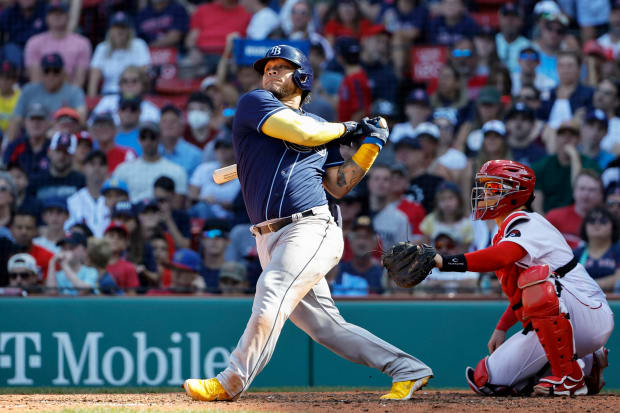On July 11 the Rays woke up to some harsh realities: Star shortstop Wander Franco was the latest addition to an already-crowded injured list, they had just been swept by the lowly Reds, and the Yankees were 15.5 games ahead of them in the American League East. That prompted one writer—who shall remain nameless—to write this story. Even after Tampa Bay won six of seven heading into the All-Star break, a sluggish end to July and start to August portended little hope that a turnaround was in the works.
As has been the case for the past four years, count the Rays out at your own peril.
Since Aug. 12—when Tampa Bay held a 58–53 record and a 41.9% chance at making the playoffs, per FanGraphs—the Rays have been the American League’s hottest team, winning 17 of their last 22 games to shrink New York’s division lead to just 5.5 games. In the process, they’ve improved their playoff odds from worse than a coin flip to a near certainty, upping the mark to 95.4% with 29 games to go following Monday’s 4–3 comeback win over the Red Sox.
The game was a microcosm of how the Rays have managed to peak despite being without ace Shane McClanahan, second baseman Brandon Lowe, center fielder Kevin Kiermaier, righty reliever Andrew Kittredge, just to name a few. Seven of the nine starters recorded at least one hit, with four different players driving in runs. Starting pitcher Luis Patiño—a former top prospect that Tampa Bay acquired from the Padres in the Blake Snell trade—went five solid innings, giving way to a quartet of relief pitchers who combined for four scoreless frames with nine strikeouts.
The game-winning RBI was notched by David Peralta, who went to the Rays in a low-profile deadline deal from the Diamondbacks and has since posted a .284/.340/.400 slash line in 26 games with his new team. Righthander Pete Fairbanks got the save this time, the fourth different player to record a save in the past four opportunities. As it often is with these Rays, it was an all-hands-on-deck effort.
So how has Tampa Bay managed such a stark turnaround? Pitching, for starters. Since Aug. 13, no team has a better ERA than the Rays’ 2.17 mark, more than a full run better than Tampa Bay’s season ERA before that date (3.48). The Rays have taken their usual pinpoint command to new heights, with a minuscule 5.6% walk rate since Aug. 13, down from 6.6% prior to then. While it’s taken a full cast of characters to produce such stellar results, the rotation has thrived behind two ascendent arms that are all the more important given McClanahan’s absence: righty Drew Rasmussen and lefty Jeffrey Springs.
In eight second-half starts, Rasmussen is 4–1 with a 1.84 ERA, striking out 41 hitters with just six walks in 44 innings. Opposing batters have managed just a .201/.238/.277 slash line against him, with only seven extra-base hits. Springs has been nearly as dominant, with a 2.74 ERA in eight post-All-Star break outings. He’s struck out 47 batters in the process, lasting at least five innings in seven straight starts after doing so just six times in his first 11 starts.
The Rays have been able to amass unparalleled depth on offense, and a look under the hood into just how the roster was assembled speaks to the power of the organization’s flexibility. Two of the five most valuable hitters on the team (based on FanGraphs WAR)—Harold Ramírez and Isaac Paredes—did not open spring training with the Rays. Since joining the team Aug. 2 after a trade from the Astros, center fielder Jose Siri is third on the team in fWAR (0.9) and is batting .275/.327/.418 with two home runs and five stolen bases in 98 plate appearances. Of the nine starting position players in Monday’s starting lineup, five of them were playing for different organizations on Opening Day.

Winslow Townson/USA TODAY Sports
That’s what the Rays are: a shape-shifting, relentless entity that bends to its needs and is always light on its feet in the name of efficiency. Whatever the roster is in its current state is never set in stone, always ready to dip into its reserve for the next anonymous reliever or unknown outfielder. Just when you think they’re out, the Rays maneuver back in through sheer calculus and marginal gains.
There’s a well-tread narrative that the way the Rays win is not fun, and it’s a fair assessment that’s well-earned given the hedge fund-esque manner in which the front office conducts business, which often yields results at the cost of building a lasting, meaningful relationship between its fan base and veteran, beloved players. But it doesn’t make it any less impressive when a team loses its phenom and Cy Young Award candidate and soars to a 92-win pace thanks to names like Yandy Díaz, Manuel Margot, Jason Adam and Brooks Raley. The Rays are a machine, and if they continue to make the right tweaks here and adjustments there, they’ll be full systems go come October.







